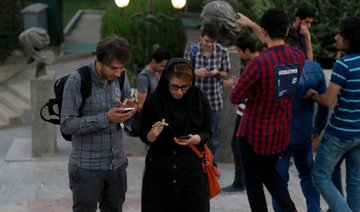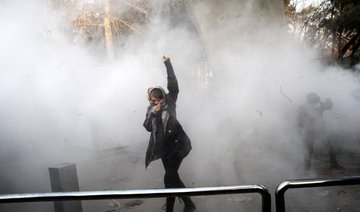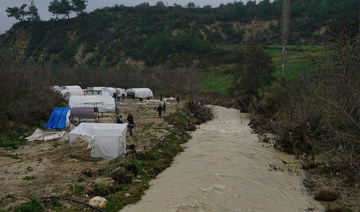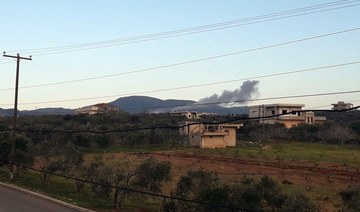TEHRAN: Some 200 protesters marched through central Tehran Sunday as authorities braced for a possible fourth night of unrest and cut access to social media after days of unrest that saw two people killed.
A security deputy for Tehran’s governor told the ILNA news agency that 200 people had been arrested after protests on Saturday night — including 40 “leaders.”
The interior minister warned that protesters will “pay the price” as footage on social media showed thousands marching across the country overnight in the biggest test for the Islamic republic since mass demonstrations in 2009.
The demonstrations began in second city Mashhad on Thursday over high living costs, but quickly spread and turned against the system as a whole, with slogans such as “Death to the dictator.”
Lorestan province deputy governor Habibollah Khojastehpour told state television that two people were killed in clashes in the small western town of Dorud late Saturday, but denied security forces were responsible.
In an apparent attempt to stave off more unrest, the authorities began blocking access to photo sharing and online messaging services on mobile phones, including Telegram, which the government accused of being used to foment violence, local media and Telegram’s CEO said.
The conservative-linked Fars news agency said around 200 people were taking part in the latest protest in Tehran.
“Contrary to rumors from hostile media, most parts of Tehran are calm. Around 200 people are occasionally chanting here and there,” it said.
Fars said shops closed early Sunday “for fear of damage to their shops by rioters.”
After initial silence, state media has shown footage of unrest, focusing on young men violently targeting banks and vehicles, an attack on a town hall in Tehran, and images of a man burning the Iranian flag.
“Those who damage public property, disrupt order and break the law must be responsible for their behavior and pay the price,” Interior Minister Abdolrahman Rahmani Fazli said on state television.
“The spreading of violence, fear and terror will definitely be confronted,” he added.
US President Donald Trump said the “big protests” showed people “were getting wise as to how their money and wealth is being stolen and squandered on terrorism.”
“Looks like they will not take it any longer,” he wrote on Twitter, warning that Washington is “watching very closely for human rights violations!“
Trump’s ambassador to the UN, Nikki Haley, said Iran’s government was “being tested by its own citizens.”
Iranian authorities have sought to distinguish anti-regime protesters from what they see as legitimate economic grievances.
“Do not get excited,” parliament director for international affairs Hossein Amir-Abdollahian wrote in a tweet directed at Trump.
“Sedition, unrest and chaos are different from gatherings and peaceful protests to pursue people’s livelihoods,” he said.
But there have been reminders of the continued support for the regime among conservative sections of society, with pro-regime students holding another day of demonstrations at the University of Tehran.
They had outnumbered protesters at the university on Saturday.
The total number of arrests from the protests around the country remained unclear.
Several hundred people were shown gathering in the western city of Kermanshah Sunday, according to footage shared online by a group linked to the powerful Revolutionary Guards.
An official in Arak, around 300 kilometers (190 miles) southwest of Tehran, said 80 people had been detained there overnight.
Police have so far taken a relatively soft approach to the unrest.
President Hassan Rouhani has not yet made any statement since the protests started.
He came to power in 2013 promising to mend the economy and ease social tensions, but anger over high living costs and a 12-percent unemployment rate have left many feeling that progress is too slow.
Unemployment is particularly high among young people, who have grown up in a less restrictive environment and are generally considered less deferential to authority.
“Rouhani has run an austerity budget since 2013 with the idea that it’s a tough but necessary pill to swallow to manage inflation and currency problems and try to improve Iran’s attractiveness for investment,” said Esfandyar Batmanghelidj, founder of the Europe-Iran Forum.
“But choosing years of austerity immediately after a very tough period of sanctions is bound to test people’s patience,” he told AFP.
Since the ruthless repression of the 2009 protests against a disputed presidential election that gave hard-liner Mahmoud Ahmadinejad a second term, many middle-class Iranians have abandoned hope of securing change from the streets.
But low-level strikes and demonstrations have continued, with bus drivers, teachers and factory workers protesting against unpaid wages and poor conditions.
Protesters march again in Tehran as 200 arrested, 2 killed
Protesters march again in Tehran as 200 arrested, 2 killed

One Palestinian killed, eight wounded in Israeli strike on West Bank refugee camp

- Israel has killed more than 35,000 Palestinians, according to Gaza’s Health Ministry
RAMALLAH, West Bank: At least one person was killed and eight wounded on Friday in an Israeli air strike on the Jenin refugee camp in the occupied West Bank, the Palestinian health ministry and Israeli military said.
The Palestinian health ministry said the eight wounded people were in stable condition and receiving treatment at hospitals. Reuters could not immediately confirm their identities.
The Israeli military said a fighter jet conducted the strike, a rarity in the West Bank, where violence had been surging long before the Gaza war.
Residents of the refugee camp said a house was targeted.
The West Bank is among territories Israel occupied in a 1967 Middle East war. Palestinians want it to be the core of an independent Palestinian state.
Trapped US doctors are out of Gaza, White House says

- The Palestinian American Medical Association, a US-based non-profit, reported that its team of 19 health care professionals, including 10 Americans, had been denied exit from Gaza after their two-week mission
- Israel has killed more than 35,000 Palestinians in Gaza, mostly women and children, according to the health ministry in the Hamas-run territory
WASHINGTON: A group of US medical workers left the Gaza Strip after getting stuck at the hospital where they were providing care, the White House said on Friday.
Reports emerged earlier this week of American doctors being unable to leave Gaza after Israel closed the Rafah border crossing, including 10 from the US-based Palestinian American Medical Association, who had intended to leave after a two-week mission at the European Hospital in Khan Younis, a city near Rafah in southern Gaza.
On Friday, 17 American doctors and health care workers, out of a total of 20, got out of Gaza, White House national security spokesperson John Kirby told reporters.
“I can assure you that any of them that wanted to leave are out,” Kirby said.
A State Department spokesperson told Reuters that some of the doctors that had been stuck made their way to safety with assistance from the US Embassy in Jerusalem.
Three of the US doctors chose not to depart Gaza, a source familiar with the situation said, adding that the doctors who stayed behind understood that the US Embassy may not be able to facilitate their departure as it did on Friday.
The Palestinian American Medical Association, a US-based non-profit, reported that its team of 19 health care professionals, including 10 Americans, had been denied exit from Gaza after their two-week mission.
The organization said on social media on Wednesday that it had a more doctors waiting to enter Gaza to replace the workers trying to leave.
Israel seized and closed the Rafah border crossing between Gaza and Egypt on May 7, disrupting a vital route for people and aid into and out of the devastated enclave.
Gaza’s health care system has essentially collapsed since Israel began its military offensive there after the Oct. 7 cross-border attacks by Palestinian Hamas militants on Israelis.
Aid deliveries began arriving at a US-built pier off the Gaza Strip on Friday.
Protests against powerful group persist in Syria’s last major rebel stronghold

- Protests took place Friday in several areas, including the provincial capital of Idlib and major towns such as Jisr Al-Shughour, Binnish and Sarmada
- Officials at one hospital in Binnish said they had received 36 people who suffered bruises and tear gas inhalation
IDLIB, Syria: Members of a powerful insurgent group in Syria ‘s rebel-held northwest fired into the air and beat protesters with clubs Friday, injuring some of them as protests intensified to demand the release of detainees and an end to the group’s rule.
Protests took place Friday in several areas, including the provincial capital of Idlib and major towns such as Jisr Al-Shughour, Binnish and Sarmada.
They came days after Abu Mohammed Al-Golani, the leader of Hayat Tahrir Al-Sham, or HTS, described the demonstrators as anarchists and told dignitaries in Syria’s Idlib province to persuade them to stop protesting.
The protests, which are calling for the ouster of Al-Golani, broke out in late February following the death of a member of a rebel faction, allegedly while being tortured in a jail run by HTS, which previously had links to Al-Qaeda. Since then, HTS released hundreds of detainees, but many remain in jails run by the group’s so-called General Security Agency.
“I came out against injustice. We don’t want Al-Golani and we don’t want the security fist. We want the prisoners of opinion to be out” of jails, protester Mazen Ziwani told The Associated Press.
Officials at one hospital in Binnish said they had received 36 people who suffered bruises and tear gas inhalation.
After more than 13 years of civil war and more than half a million deaths, Idlib is the last major rebel stronghold in Syria.
On Tuesday, HTS members attacked protesters with clubs and sharp objects outside a military court in Idlib city, injuring several people.
Anti-HTS sentiments had been rising since a wave of arrests by the group of senior officials within the organization, which was previously known as the Nusra Front, when it was Al-Qaeda’s branch in Syria, before changing its name several times and distancing itself from Al-Qaeda.
Over the years, Al-Golani’s HTS crushed many of its opponents to become the strongest group in the rebel-held region that stretches to the western parts of Aleppo province.
The Britain-based Syrian Observatory for Human Rights, an opposition war monitor, said HTS fighters closed major roads leading to Idlib city Friday to prevent the demonstrators from reaching the provincial capital.
Over the past years, HTS has been trying to distance itself from Al-Qaeda and market itself as a more moderate Syrian opposition group after years of strict religious rule.
In 2017, HTS set up a so-called “salvation government” to run day-to-day affairs in the region. At first, it attempted to enforce a strict interpretation of Islamic law. Religious police were tasked with making sure that women were covered, with only their faces and hands showing.
The police would force shops to close on Fridays so that people could attend the weekly prayers. Playing music was banned, as was smoking water pipes in public.
For the children of Gaza, war means no school

- Israel has killed more than 35,000 Palestinians, according to Gaza’s Health Ministry
DEIR AL-BALAH: Atef Al-Buhaisi, 6, once dreamed of a career building houses. Now, all he craves is to return to school.
In Israel’s war with Hamas, Atef’s home has been bombed, his teacher killed, and his school in Nuseirat turned into a refuge for displaced people.
He lives in a cramped tent with his family in Deir Al-Balah in central Gaza. He sleeps clinging to his grandmother and fears walking alone, even during the day.
Since the war erupted on Oct. 7, all Gaza’s schools have closed — leaving hundreds of thousands of students like Atef without formal schooling or a safe place to spend their days. Aid groups are scrambling to keep children off the streets, and their minds are focused on something other than the war as heavy fighting continues across the enclave and has expanded into the southern city of Rafah and intensified in the north.

“What we’ve lost most is our children’s future and their education,” said Irada Ismael, Atef’s grandmother.
“Houses and walls are rebuilt, money can be earned again ... but how do I compensate for (his) education?”
Gaza faces a humanitarian crisis, with the head of the UN’s World Food Programme determining a “full-blown famine” is already underway in the north.
More than 35,000 Palestinians have been killed in the war, according to the Gaza Health Ministry.
About 80 percent of Gaza’s population has been driven from homes.
Much of Gaza is damaged or destroyed, including nearly 90 percent of school buildings, according to aid group estimates.
Children are among the most severely affected, with the UN estimating some 19,000 children have been orphaned and nearly a third under the age of 2 face acute malnutrition.
Education experts say that in emergencies, education takes a back seat to safety, health, and sanitation, but the consequences are lasting.
“The immediate focus during conflict isn’t on education, but the disruption has an incredibly long-term effect,” said Sonia Ben Jaafar of the Abdulla Al Ghurair Foundation, a philanthropic organization focused on education in the Arab world.
“The cost at this point is immeasurable.”
According to the UN, Gaza had a highly literate population that included more than 625,000 students and some 20,000 teachers before the war.
In other conflicts, aid groups can create safe spaces for children in neighboring countries — for example, Poland for shelter and schooling during the war in Ukraine.
That’s impossible in Gaza, a densely populated enclave between the sea, Israel, and Egypt. Since Oct 7, Palestinians from Gaza haven’t been allowed to cross into Israel. Egypt has let a small number of Palestinians leave.
“They’re unable to flee, and they remain in an area that continues to be battered,” said Tess Ingram of UNICEF.
“It’s very hard to provide them with certain services, such as mental health and psychosocial support or consistent education and learning.”
Aid groups hope classes will resume by September. But even if a ceasefire is brokered, much of Gaza must be cleared of mines, and rebuilding schools could take years.
In the interim, aid groups are providing recreational activities — games, drawing, drama, art — not for a curriculum-based education but to keep children engaged and in a routine in an effort for normalcy. Even then, advocates say, attention often turns to the war — Atef’s grandmother sees him draw pictures only of tents, planes, and missiles.
Finding free space is among the biggest challenges.
Some volunteers use the outdoors, make do inside tents where people live, or find a room in still-standing homes.
It took volunteer teachers over two months to clear one room in a school in Deir Al-Balah to give ad hoc classes to children. Getting simple supplies such as soccer balls and stationery into Gaza can also take months, groups report.
“Having safe spaces for children to gather to play and learn is an important step,” Ingram said, but “ultimately, the children of Gaza must be able to return to learning curriculum from teachers in classrooms, with education materials and all the other support schooling provides.”
This month, UNICEF had planned to erect at least 50 tents in Rafah for play-based numbers and literacy learning for some 6,000 children from preschool to grade 12. But UNICEF says Israel’s operation there could disrupt those plans.
Lack of schooling can take a psychological toll — it disrupts daily life and, compounded with conflict, makes children more prone to anxiety and nervousness, said Jesus Miguel Perez Cazorla, a mental health expert with the International Committee of the Red Cross.
Children in conflicts are also at increased risk of forced labor, sexual violence, trafficking, and recruitment by gangs and armed groups, experts warn.
“Not only are children vulnerable to recruitment by Hamas and other militant groups, but living amid ongoing violence and constantly losing family members makes children psychologically primed to want to take action against the groups they consider responsible,” said Samantha Nutt of War Child USA, which supports children and families in war zones.
Palestinians say they have seen more children take to Gaza’s streets since the war, trying to earn money for their families.
“The streets are full of children selling very simple things, such as chocolate and canned goods,” said Lama Nidal Alzaanin, 18, who was in her last year of high school and looking forward to university when the war broke out. There is nothing for them to do.”
Some parents try to find small ways to teach their children, scrounging for notebooks and pens and insisting they learn something as small as a new word each day. But many find the kids are too distracted with the world at war.
Sabreen Al-Khatib, a mother whose family was displaced to Deir Al-Balah from Gaza City, said it’s particularly hard for the many who’ve seen relatives die.
“When you speak in front of children,” Al-Khatib said, “what do you think he is thinking? Will he think about education? Or about himself, how will he die?”
On Oct. 7, 14-year-old Layan Nidal Alzaanin — Lama’s younger sister — was on her way to her middle school in Beit Hanoun when missiles flew overhead, she said. She fled with her family to Rafah, where they lived crowded in a tent.
Since Israel ordered evacuations there, she fled to Deir Al-Balah.
“It is a disaster,” she said.
“My dreams have been shattered. There is no future for me without school.”
Iraq’s Kurdish Regional Security Council announces arrest of top aide of former Daesh leader

- Khalil made bombs for the Daesh and was entrusted by Al-Baghdadi with various major operations
BAGHDAD: The Kurdish Regional Security Council announced in a statement on Friday that it captured a senior Daesh figure, Socrates Khalil.
Khalil was known to be a confidant of the late Daesh leader, Abu Bakr Al-Baghdadi.
“After spending five years in Turkiye, Khalil returned to Kurdistan with a forged passport and was swiftly apprehended,” the statement said.
Khalil made bombs for the Daesh and was entrusted by Al-Baghdadi with various major operations, the statement added, saying that he was instrumental in the 2014 Daesh takeover of Mosul, and participated in many battles against Iraqi forces and the Peshmerga forces.





















